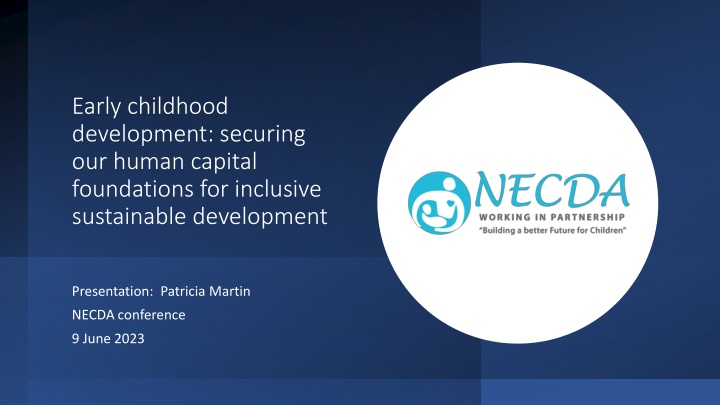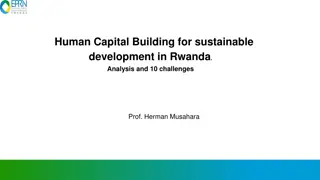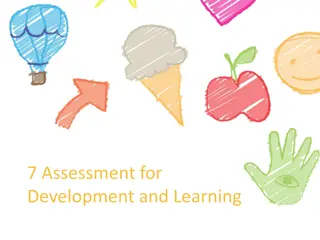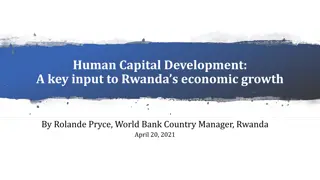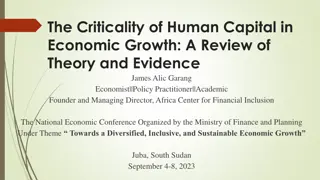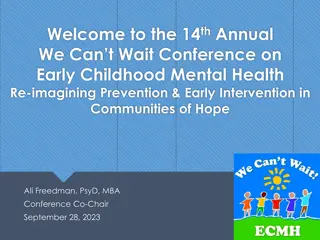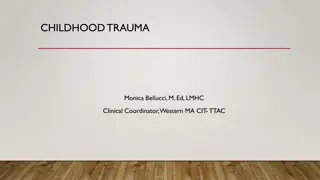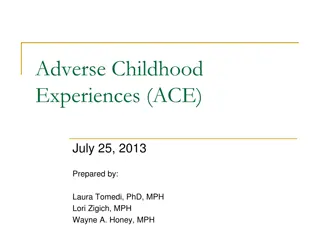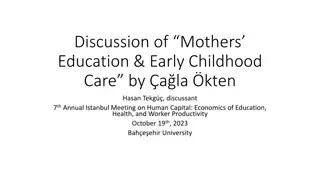Building Human Capital Through Early Childhood Development
Investing in early childhood development is crucial for securing human capital foundations and achieving inclusive, sustainable development goals. Global commitments and frameworks emphasize providing equitable access to quality education and nurturing care to ensure children reach their full potential. Governments play a pivotal role in directing resources towards optimizing early development outcomes and promoting long-term health, knowledge, and resilience, particularly among marginalized communities. The Nurturing Care Framework underscores the importance of health, nutrition, responsive caregiving, and early learning opportunities in fostering children's holistic development.
Download Presentation

Please find below an Image/Link to download the presentation.
The content on the website is provided AS IS for your information and personal use only. It may not be sold, licensed, or shared on other websites without obtaining consent from the author.If you encounter any issues during the download, it is possible that the publisher has removed the file from their server.
You are allowed to download the files provided on this website for personal or commercial use, subject to the condition that they are used lawfully. All files are the property of their respective owners.
The content on the website is provided AS IS for your information and personal use only. It may not be sold, licensed, or shared on other websites without obtaining consent from the author.
E N D
Presentation Transcript
Early childhood development: securing our human capital foundations for inclusive sustainable development Presentation: Patricia Martin NECDA conference 9 June 2023
2015 SDGs: By 2030, all children will have equitable access to quality early childhood development and early learning opportunities Incheon Declaration Convention on the Rights of the Child and General Comment Nr. 7 African Charter on the Rights and Welfare of the Child Continental Education Strategy for Africa African Union Agenda 2063 Africa s Agenda for Children 2040 Global Partnership Strategy for Early Childhood 2021 2030 (UNESCO) Call to Act Together (UNESCO) Nurturing Care Framework for ECD Tashkent Declaration TES Summit Declaration 2022 Long history of global and regional commitments by governments governments to increase investments and universalise ECD by
SDG 4.2.1 The proportion of children aged 24 59 months that are developmentally on track in terms of health, learning and psycho-social wellbeing Critically: Governments are the responsible agents and have committed to direct public resources to change outcomes for young children to change national trajectories SDG 4.2.2 Participation rate of children in organised learning by sex in one year of pre-school Especially among historically marginalised families and communities To lay solid human capital foundations Increase the Human Capital Index a measurement of progress in children s achievement of their full potential To ensure the long-term development of the health, knowledge, skills and resilience of all, especially the chronically marginalised to achieve transformation and inclusive, sustainable development
How is early development equalised and optimized to build human capital? Formula is simple Science is clear Legal basis is clear on the implementation commitments All captured in the global Nurturing Care Framework
Nurturing care Nurturing care for development for development requires requires Health and nutrition Responsive caregiving, safety and protection The right ingredients Opportunities for early learning In the right combinations Correct quantities At the right time Using the right instruments Provided by experts To meet the special needs of children Children develop to their full potential Mandated (implicitly) by legal and development instruments
Like baking a cake: the ingredients of nurturing care on their own are not enough Eggs Flour Milk Baking powder Sugar Cocoa Icing sugar
Even if you have all the ingredients, but not the recipe and do not know what and how many you are baking for will fail Need to know what you are baking, for who and how many Need to know how to bake in the right quantities and combinations But a recipe without the resources needed to produce a good product is not any good Need to all know what a good product looks like and how you know if you have baked a good product
Government-wide prioritisation and implementation of its ECD treaty and development commitments to achieve a shared goal all aspire and relate to sustainable, inclusive development What is required to achieve these outcomes?
Global treaty and development commitments create a duty on governments to realise early child development Nurturing care framework harnesses evidence and provides guidelines on how to fulfil the implementation responsibilities Regional and sub-regional commitments implicitly obligate equal and optimal ECD Aligned sectoral policies health, education, protection, wash, social security National Integrated Multisectoral ECD policy and Programme/ Recipe Multi-sectoral support across the life cycle of every young child Services in appropriate combinations to address risks faced by families To enable parents, families and caregivers to provide the nurturing care needed Integrated programmes to reach all and provide Sustained quality services across five domains Specialised services for children at higher risk Universal basic services
It is for this reason that optimal early development cannot be achieved without a supporting system The Nurturing Care Framework therefore calls on government to develop a national inclusive multi-sectoral public ECD system to operationalise the NCF to universal, sustained nurturing care A system is built on the following foundational building blocks to provide leadership and a mandate to all role players to provide the services required to secure nurturing care through their aligned sector -systems National multi- sectoral ECD policy that defines a shared ECD goal and a government- wide mandate & National and sectoral leadership and coordination of ECD as a national development priority Human resources for the development, delivery, monitoring and ongoing quality improvement of all services Information management system for evidence-based planning, monitoring and evaluation of outcomes Integrated, inclusive ECD programme committing to provide combinations of services Infrastructure to support the policy, system and programmes Adequate and sustainable financial resources Aligned sectoral policies and laws
Logic and essential requirements for public universal provision of ECD to equalise and optimise development What does it look like and what are the levels of monitoring and measurment
Human capital for sustainable inclusive development increased Every young child develops to their full potential Responsive caregiving Early learning from birth Safety and protection Nutrition Health Parents and other caregivers access combinations of services and are enabled to provide nurturing care Health services: promotive, preventative and therapeutic Parenting / family support and services Age-differentiated early learning services from birth Birth registration Child protection Basic services Nutritional support Nutrition and food security Labour and social protection Health ministry Social Local Gender Water and sanitation Education Disability development government National public ECD system that ensures all ministries recognise ECD as a priority and direct their resources to provide services in required combinations
What is the purpose What is the purpose of the ECD system? of the ECD system? To secure government-wide ECD- centred governance Government-wide prioritisation and actioning of ECD through coordinated planning, resourcing, monitoring and accountability for services and improved outcomes for children
Health ministry recognises ECD as development priority mainstreams its responsibilities Ministry of education and all other ministries Social Development ministry Strategic plan Strategic plan Strategic plan Annual performance plan Annual performance plan Annual performance plan Programmes Programmes Programmes Budget Budget Budget Human resources plans, systems and capacity development Human resources plans, systems and capacity development Infrastructure Infrastructure Infrastructure Information management system Information management system Information management system Government Government- -wide implementation of commitments wide implementation of commitments requires a public ECD system that ensures coordination of requires a public ECD system that ensures coordination of sectoral systems to advance ECD as a shared national sectoral systems to advance ECD as a shared national priority priority
What does this look like? Within our governance architecture?
Recognition of ECD as a national rights-based development priority by Presidency and a state-wide duty to advance an account for using resources to advance improved outcomes for young children clear shared ECD goal in the NDP, MTSF and SONA National and sector leadership and coordination mechanisms ensure government-wide prioritisation, compliance and accountability for inclusive ECD All sector policies and laws mandate programmes and resources for providing inclusive ECD services All sector plans operationalise commitments to provide inclusive ECD services across all 5 components All sector programmes delivery quality, integrated inclusive ECD services All sector budgets support implementation of inclusive ECD programmes All sector human resourcing plans support inclusive programmes All sector information management systems monitor inclusive ECD coverage, quality and impact All sectors all report on inclusive ECD responsibilities and improved outcomes Follow-up / quality improvement processes to strengthen systems and improve outcomes for children with special needs
ECD: Taking stock with 7 years to go to 2030 How well are we doing in the region and South Africa in realising ECD commitments and improved outcomes?
World Banks Human Capital Index Measure of extent of children s development and a good proxy for ECD progress viewed holistically and in terms of how well we are doing in strategic ECD to build human capital
On average, African On average, African children born today children born today can expect to achieve can expect to achieve only 40% of their only 40% of their potential productivity potential productivity by their 18 by their 18th thbirthday (World Bank, 2021) (World Bank, 2021) Adolescent pregnancies Poverty birthday Child marriages Malnutrition Why? Nurturing Care has not been systemically enabled per the Nurturing Care Framework Intergenerational development patterns fueled by worsening social and economic context Because systems are weak Poor learning outcomes Stunting Poor health
Mozambique 0.36 Common underlying causes: Human capital complementary indicators measure progress in intermediate outcomes determining - indicating need for investment at different stages to improve HCI Angola 0.36 DRC 0.37 Eswatini 0.37 ECD indicators are poor in low scoring countries because: NNMR Adolescent birth rates High levels of avoidable disability / cognitive and physical limitations that can last a life time High stunting Poor access and quality early learning Madagascar 0.39 Tanzania 0.39 Zambia 0.40 Malawi 0.41 Botswana 0.41 South Africa 0.43 Namibia 0.45 Where outcomes are better: In health for example, in Malawi because the health system has strengthened Population scale programmes antenatal health care coverage, birth registration Zimbabwe 0.47 Mauritius 0.62 Seychelles 0.63
Despite the adoption of an integrated ECD policy almost 10 years ago that commits to operationalising the Nurturing Care Framework and provides the road map to do so Despite a deliberate pro-poor policy and increased health and education budgets (World Bank, 2021) South Africa s Human Capital Index (HCI) has not changed in 10 years. A child born 10 years ago would only develop 43% of their potential. Most at risk are historically marginalised Development and exclusions start early in life Fuels lifelong trajectory and patterns of exclusions and inequalities Stunting has increased - almost of children under 5 affected Only 1/3rd of under 5 s are developmentally on track (Thrive by Five, 2022) 80% of children in Grade 4 cannot read for meaning (Spaull, 2023) NEET rate not in education, employment or training is more than 30% and increased over the last 10 years. 1/3 of young people remain chronically excluded. These are the parents of the next generation, who, unless we change the story now, will be born into greater adversity and less capacity for nurturing care Breaking this cycle requires improving development of children at population scale South Africa is not doing better than the region
Why are we seeing this in the region and in South Africa? We adopted the ECD policy, committing to implement our obligations by establishing a robust ECD system, but have not followed through
Human capital for sustainable inclusive development increased Every young child develops to their full potential Responsive caregiving Early learning from birth Safety and protection Health Nutrition Parents and other caregivers access combinations of services and are enabled to provide nurturing care Health ministry Local government Health services: promotive, preventative and therapeutic Nutritional support Parenting / family support and services Age-differentiated early learning services from birth Birth registration Child protection Basic services Labour and social protection Education Social Water and sanitation development Nutrition and food security Gender Disability Weak public ECD systems designed around realising ECD as a shared, national development responsibility
Programmes at scale in combination to address out biggest risks? Leadership Coordination Do we have a measurable shared, outcomes-based ECD goal such as improve the HCI, improve the Thrive by Five index? Is it referenced in the NDP, MTSF, SONA? SOPA and IDPs? Do we measure progress and report on this during annual and mid-term reviews as a country? Do we have real coordination in the sense that all sectoral systems are aligned to recognise and contribute to the achievement of the shared goal? Do we have inter- and intra- sectoral alignment? Is ECD governance embedded in the governance architecture established to drive government- wide actioning of all other SDGs? Micronutrient supplementation of all girls of child-bearing age Stunting Integrated ECD 5 pillars per the RtHB in the public health system to enable nurturing care at all contacts with pregnant women, infants and babies in the 1st3 years Sustainable, transformational parenting programmes at scale addressing responsive caregiving, positive parenting, nutrition for example through the education system Mental health care for pregnant women and new mothers Routine screening and referrals for violence, abuse and substance abuse
Human resourcing Financial resourcing Information management, data analysis and reporting Do we have the capacity across the governance continuum for ECD-centred governance? Leadership, coordination and evidence-based planning, resourcing, monitoring and accountability across the governance continuum, in: Has there been a shift in resourcing policies and priorities to address our biggest gaps earliest years, nutrition, responsive caregiving Do we have a shared ECD goal Is it measurable and measured Is it in the MTSF Is there resourcing coherence to support a coherent system and integrated ECD provisioning Is it mainstreamed across all sector IMSs? The Presidency DPME Recent resourcing assessment by World Bank et al found that they could only assess allocations and improved allocations for services after the age of 3 and then primarily for early learning Are we measuring outcomes and systems strengthening progress - not just inputs? Provincial Premier Offices Local Mayoral Offices All ministries not just DBE, but health, environment, women Parliament Have we seen shifts in resourcing to balance provisioning and enable nurturing care through the public health system and community outreach programmes?
What will it take to bring about change? To fundamentally strengthen a national ECD system across all components?
Government Government- -wide understanding, action and wide understanding, action and accountability through ECD accountability through ECD- -centred governance centred governance This however fundamentally depends on high level ECD leadership, guidance on implementation responsibilities and how to fulfil them, coordination, and accountability at global, regional and national levels
Coordination and aligned implementation for Coordination and aligned implementation for improved outcomes is not possible without improved outcomes is not possible without effective leadership effective leadership GLOBAL REGIONAL NATIONAL SECTORAL
Will not happen without high-level, credible leadership of ECD and a very specific national ECD goal as a national, rights-based development priority To shift resourcing, to shift programming, to shift systemic human resources developing is a political ask It must be led from the top as a period of development dependent on a whole of government response not just ECE By the Presidency, Premiers, Mayors (and ultimately the politicians) This is what determines government-wide planning, prioritisation, monitoring and accountability In the NDP, MTSF, SONA With respect, DBE is an administrative structure, not a political leader. Expecting the function shift to catalyse the systemic changes we need to see is not realistic We have changed our coordination arrangements without strengthening leadership
SMART advocacy Strategic, specific, timely, relevant For improved early development outcomes as a national development priority Led by the Presidency Embedded in the national governance architecture that drives all other development goals It requires long-term, sustained, multi- sectoral advocacy Which can only be done collectively through alliance structures It works and it can work better now. The time is right We have a window of opportunity that will not be open for another decade or more if we miss it To get this we need
Improved access to ECD centres infrastructure grant, conditional grant programme It worked for driving the ECD changes we have seen 2 years publicly provided early learning Grade R plus universalisation Function shift to DBE Measured, Monitored, Reported, Understood Need to see the same shifts across all domains and strengthening of the national system But it has not been enough to change the end of the story for young and older children To improve early outcomes Will only happen if we advocate for very specific, SMART, carefully chosen catalytic asks Now, as the world is taking stock of its slow / no progress on SDGs Emphasis on science of 1st years And as we move out of our long term plan to the next NDP and out of the current Medium Term Planning Framework to the next Make sure we have the right priorities, framing and mandate in the next NDP, the next MTSF to provide leadership that will catalyse government-wide coordination
Is NECDA up for the challenge? Thank you
